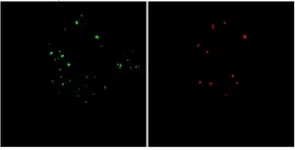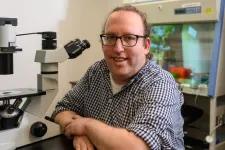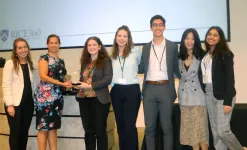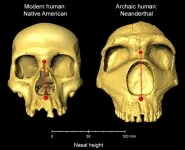(Press-News.org) The University of Minnesota Twin Cities announced that it will receive a $20 million grant over five years from the National Science Foundation (NSF) and the U.S. Department of Agriculture’s (USDA) National Institute of Food and Agriculture (NIFA) to lead a new National Artificial Intelligence Research Institute.
Researchers at the AI Institute for Climate-Land Interactions, Mitigation, Adaptation, Tradeoffs and Economy (AI-CLIMATE) aim to leverage artificial intelligence (AI) to create more climate-smart practices that will absorb and store carbon while simultaneously boosting the economy in the agriculture and forestry industries.
The new institute is one of seven new NSF- and NIFA- funded AI Institutes announced today and is part of a larger federal initiative—totaling nearly half a billion dollars—to bolster collaborative artificial intelligence research across the country.
AI-CLIMATE is a joint effort between the University of Minnesota Twin Cities College of Science and Engineering; Minnesota Robotics Institute; Data Science Institute; College of Food, Agricultural, and Natural Resource Sciences; and the Office of the Vice President for Research. It will also bring together scientists and engineers from across the country, including national experts on artificial intelligence and climate-smart ag and forestry from Cornell University, Colorado State University, Delaware State University, Purdue University, and North Carolina State University. In addition, the researchers will collaborate with the American Indian Higher Education Consortium (AIHEC) and the tribal nations it represents.
“One of the driving factors of climate effects is carbon emissions,” said Shashi Shekhar, director of the institute and a professor in the University of Minnesota Department of Computer Science and Engineering. “By 2050, the United States aims to have net zero carbon emissions, and one of the most promising ways to do this is using natural systems like forestry and agriculture as ‘carbon sinks.’”
Farms and forests can be used as carbon sinks, which pull more carbon dioxide out of the atmosphere than they release. Farmers and foresters may be rewarded for doing this through carbon markets, or systems in which property owners can sell “carbon credits”—equal to the amount of carbon dioxide their farm or forest has sequestered—to companies trying to offset their carbon emissions. However, with current technology, it’s both difficult and expensive for farmers and foresters to accurately measure how much carbon they’ve sequestered.
Using new AI techniques like deep learning and knowledge-guided machine learning, researchers at the AI-CLIMATE institute are improving accuracy and lowering the cost of accounting for carbon and greenhouse gases in farms and forests, ultimately making the process more accessible for more people.
“When farmers touch, smell, and look at the soil, they can tell if it’s carbon rich or not,” Shekhar said. “But, they can’t manually survey thousands of acres of land every year. We’re developing easy-to-use tools where we can show all of these measurements and images of the soil to an AI neural network and let it figure it out for us, saving farmers and foresters time, energy, and money."
The goals of AI-CLIMATE directly intersect with what other federal programs are doing to further develop climate-smart agriculture. In 2022, the United States Department of Agriculture announced that it would be investing $3.1 billion to support farmers, ranchers, and private forest landowners through its Partnerships for Climate-Smart Commodities project.
“In the tradition of USDA National Institute of Food and Agriculture investments, this new institute leverages the scientific power of U.S. land-grant universities, informed by close partnership with farmers, producers, educators and innovators to address the grand challenge of rising greenhouse gas concentrations and associated climate change,” said Dionne Toombs, acting director of NIFA. “This innovative center will address the urgent need to counter climate-related threats, lower greenhouse gas emissions, grow the American workforce, and increase new rural opportunities.”
"Foundational research in AI and machine learning has never been more critical to the understanding, creation, and deployment of AI-powered systems that deliver transformative solutions across our society," said Margaret Martonosi, NSF assistant director for computer and information science and engineering. “These recent awards, as well as our AI Institutes ecosystem as a whole, represent our active efforts in addressing national economic and social priorities that hinge on our nation’s AI capability and leadership.”
END
University of Minnesota to lead new $20M AI Institute focusing on climate-smart agriculture and forestry
The new AI-CLIMATE institute will leverage artificial intelligence to create more sustainable agriculture and forestry industries
2023-05-08
ELSE PRESS RELEASES FROM THIS DATE:
Hispanic women face inequities affecting maternal health outcomes
2023-05-08
DALLAS, May 8 2023 — Cardiovascular disease is the No. 1 killer of new moms.[1] The American Heart Association, through the new campaign, “My health is our health”/ “Mi salud es nuestra salud” is raising awareness among Hispanic/ Latina moms, especially during pregnancy, about the importance of managing their blood pressure. On average, about one in every 16 Hispanic women aged 20 and older have coronary heart disease, the most common type of heart disease.[2]
Hispanic/Latina mothers hold a special place in their homes when it comes to family decisions. They are considered the head of the family for their key role in raising children and ...
Mirror, mirror: A new way to recognize reverse-image molecules
2023-05-08
Recognizing and separating enantiomers is a difficult task for chemical engineers — one might say it gives them a bit of a headache.
Enantiomers are molecules with virtually identical compositions that mirror one another, like a left and right hand. In chemistry, this property is called chirality. Despite the similarities in their makeup, so-called left- and right-handed enantiomers often exhibit very different properties. Sometimes a drug has an enantiomer that causes undesirable effects. For example, certain drugs have one enantiomer that can cause a headache, ...
Experimental model gets cells to behave as they would in utero
2023-05-08
HOUSTON – (May 8, 2023) – Many birth defects and spontaneous abortions occur during the embryonic development stage known as neurulation, yet we have very little insight into how this critical developmental process unfolds in humans.
The Rice University lab of Aryeh Warmflash has received a five-year, $1.9 million grant from the National Institutes of Health to optimize and develop experimental cell models that can shed light on the self-organizing processes by which ectodermal ...
U of M researchers develop technique for rapid detection of neurodegenerative diseases like Parkinson’s and Chronic Wasting Disease
2023-05-08
University of Minnesota Twin Cities researchers have developed a groundbreaking new diagnostic technique that will allow for faster and more accurate detection of neurodegenerative diseases. The method will likely open a door for earlier treatment and mitigation of various diseases that affect humans, such as Alzheimer's and Parkinson's, and similar diseases that affect animals, such as chronic wasting disease (CWD).
Their new study is published in Nano Letters, a premier journal in the field of nanotechnology published by the American Chemical Society.
“This paper mainly ...
Rice University students design congenital hypothyroidism test for newborns
2023-05-08
HOUSTON – (May 8, 2023) – For newborns with congenital hypothyroidism, early diagnosis spells the difference between a normal, healthy life and lifelong disability.
After learning about the heavy toll the disease takes on children born in parts of the world where testing is limited or absent, a team of Rice University students came together to develop a low-cost screening tool that can detect abnormally high thyroid-stimulating hormone (TSH) levels indicative of dysfunction.
The point-of-care, paper-based test developed ...
Culture, diet, economic factors and more affect CVD risk among Asian Americans
2023-05-08
Statement Highlights:
Health research that considers Asian Americans as a single race and ethnic group may result in over- or under-estimating the risk of Type 2 diabetes and cardiovascular disease among people of diverse Asian American subgroups, by geographic region of descent.
Together, cardiovascular disease and Type 2 diabetes are the leading causes of death and disease in Asian American adults, however, rates vary widely among subgroups. For example, the latest data on the prevalence of Type 2 diabetes in Asian American adults, ages 45-84, reveals a range of Type ...
Nose shape gene inherited from Neanderthals
2023-05-08
Humans inherited genetic material from Neanderthals that affects the shape of our noses, finds a new study led by UCL researchers.
The new Communications Biology study finds that a particular gene, which leads to a taller nose (from top to bottom), may have been the product of natural selection as ancient humans adapted to colder climates after leaving Africa.
Co-corresponding author Dr Kaustubh Adhikari (UCL Genetics, Evolution & Environment and The Open University) said: “In the last 15 years, since the Neanderthal genome ...
Immunotherapy plus chemotherapy combination for advanced lung cancer not only prolongs life but also improves its quality
2023-05-08
A recent clinical trial showed that the drug combination of cemiplimab plus platinum chemotherapy can prolong survival in patients with advanced lung cancer when compared with placebo plus platinum chemotherapy. Now an analysis published by Wiley online in CANCER, a peer-reviewed journal of the American Cancer Society, indicates that cemiplimab plus platinum chemotherapy also affects quality of life compared to chemotherapy alone.
The multinational phase 3 EMPOWER-Lung 3 trial had shown that the addition ...
Organoids derived from patient tissues support personalized cancer treatment
2023-05-08
Chicago (May 2, 2023) — Researchers created organoids from cancer cells to reduce the need for trial and error in identifying effective cancer treatments in one of many cancer studies scheduled for presentation this week at Digestive Disease Week® (DDW) 2023.
Below are summaries of three studies scheduled for DDW, their embargo times and presentation times at the meeting in Chicago May 6-9.
Personalized drug screening in patient-derived organoids of biliary tract cancer and its clinical application
Chemotherapy is often the only treatment option for biliary tract cancer, which is usually found at a late stage, making it one of the most lethal ...
Cognitive behavioral therapy lessens post-viral fatigue after COVID-19
2023-05-08
Those with post-viral fatigue after suffering from COVID-19 benefit from cognitive behavioural therapy, resulting in less fatigue and concentration problems. Lead researcher, Hans Knoop, Professor of Medical Psychology at Amsterdam UMC found that “After behavioural therapy, patients not only had less symptoms but also functioned better both physically and socially. Those improvements were still present even after six months.” Today, research from Amsterdam UMC, RadboudUMC and three other hospitals is published in Clinical Infectious Diseases.
After a COVID-19 infection, a substantial number of patients report persisting symptoms. This is often known as long-COVID or ...
LAST 30 PRESS RELEASES:
Flaring black hole whips up ultra-fast winds
Study explores the link between newspaper preference and attitudes towards autism
Artificial turf in the Nordic climate – a question of sustainability
The hidden toll of substance use disorder: annual cost of lost productivity to US economy nearly $93 billion
Among psychologists, AI use is up, but so are concerns
Recycling a pollutant to make ammonia production greener
Common institutional ownership linked to less aggressive business strategies in Chinese firms
Energy and regional factors drive carbon price volatility in China’s emissions trading markets
Researchers from NUS Medicine and the Institute of Mental Health detect early brain changes linked to future psychosis development
Cryopreserved vs liquid-stored platelets for the treatment of surgical bleeding
Cost-effectiveness of cryopreserved vs liquid-stored platelets for managing surgical bleeding
Adaptive Kalman filter boosts BDS-3 navigation accuracy in challenging environments
Home-based monitoring could transform care for patients receiving T-cell redirecting therapies
Listening to the 'whispers' of electrons and crystals: A quantum discovery
Report on academic exchange (colloquium) with Mapua University
Sport in middle childhood can breed respect for authority in adolescence
From novel therapies to first-in-human trials, City of Hope advances blood cancer care at the American Society of Hematology (ASH) annual conference
Research aims to strengthen the security of in-person voting machines
New study exposes hidden Alzheimer’s 'hot spots' in rural Maryland and what they reveal about America’s growing healthcare divide
ASH 2025: Study connects Agent Orange exposure to earlier and more severe cases of myelodysplastic syndrome
ASH 2025: New data highlights promise of pivekimab sunirine in two aggressive blood cancers
IADR elects George Belibasakis as vice-president
Expanding the search for quantum-ready 2D materials
White paper on leadership opportunities for AI to increase employee value released by University of Phoenix College of Doctoral Studies
ASH 2025: New combination approach aims to make CAR T more durable in lymphoma
‘Ready-made’ T-cell gene therapy tackles ‘incurable’ T-cell leukemia
How brain activity changes throughout the day
Australian scientists reveal new genetic risk for severe macular degeneration
GLP-1 receptor agonists likely have little or no effect on obesity-related cancer risk
Precision immunotherapy to improve sepsis outcomes
[Press-News.org] University of Minnesota to lead new $20M AI Institute focusing on climate-smart agriculture and forestryThe new AI-CLIMATE institute will leverage artificial intelligence to create more sustainable agriculture and forestry industries






